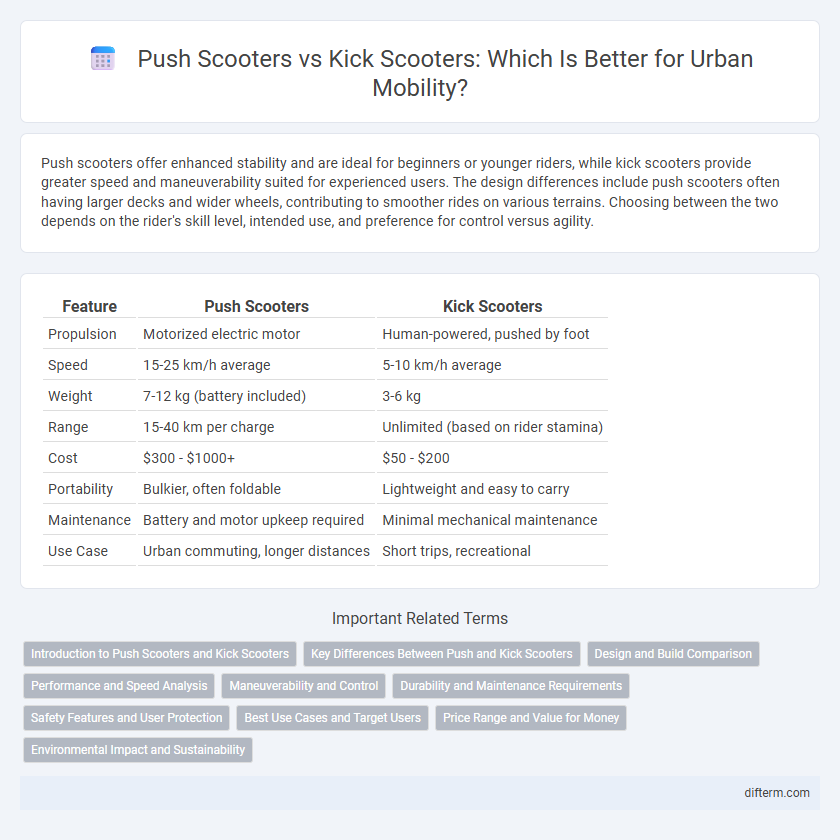Push scooters offer enhanced stability and are ideal for beginners or younger riders, while kick scooters provide greater speed and maneuverability suited for experienced users. The design differences include push scooters often having larger decks and wider wheels, contributing to smoother rides on various terrains. Choosing between the two depends on the rider's skill level, intended use, and preference for control versus agility.
Table of Comparison
| Feature | Push Scooters | Kick Scooters |
|---|---|---|
| Propulsion | Motorized electric motor | Human-powered, pushed by foot |
| Speed | 15-25 km/h average | 5-10 km/h average |
| Weight | 7-12 kg (battery included) | 3-6 kg |
| Range | 15-40 km per charge | Unlimited (based on rider stamina) |
| Cost | $300 - $1000+ | $50 - $200 |
| Portability | Bulkier, often foldable | Lightweight and easy to carry |
| Maintenance | Battery and motor upkeep required | Minimal mechanical maintenance |
| Use Case | Urban commuting, longer distances | Short trips, recreational |
Introduction to Push Scooters and Kick Scooters
Push scooters, powered by a rider's foot pushing against the ground, offer a compact and portable mobility option ideal for short urban commutes and recreational use. Kick scooters share similar mechanics but often feature a sturdier frame and larger wheels, enhancing stability and smoothness on varied terrain. Both types prioritize manual propulsion, promoting eco-friendly transportation and physical activity.
Key Differences Between Push and Kick Scooters
Push scooters feature a motorized system, offering increased speed and requiring minimal physical effort, making them ideal for longer commutes in urban environments. Kick scooters rely solely on human power, providing greater control, portability, and fitness benefits for short distances or recreational use. Key differences include the presence of a battery and throttle in push scooters versus the manual propulsion and lightweight design characteristic of kick scooters.
Design and Build Comparison
Push scooters and kick scooters differ notably in design and build, with push scooters typically featuring a motorized frame, reinforced deck, and robust wheels optimized for speed and durability. Kick scooters boast a minimalist, lightweight design, often constructed from aluminum or steel, emphasizing portability and ease of manual propulsion. The build of push scooters incorporates advanced suspension systems and battery compartments, whereas kick scooters rely on simplicity and mechanical efficiency to enhance rider control and maintenance.
Performance and Speed Analysis
Push scooters typically provide higher performance and speed due to their motorized assistance, enabling riders to reach speeds between 15 to 25 mph, which is ideal for longer commutes. Kick scooters rely solely on human power, resulting in lower speeds averaging 5 to 10 mph but offering greater control and agility in crowded urban environments. Advanced electric push scooters often feature variable speed modes and enhanced battery capacity, optimizing efficiency and ride quality compared to the manual propulsion of kick scooters.
Maneuverability and Control
Push scooters offer superior maneuverability due to their lightweight design and responsive steering, making them ideal for urban environments with tight corners and crowded spaces. Kick scooters provide enhanced control and stability through a more robust frame and larger wheels, which are beneficial for longer distances and varied terrains. Choosing between push and kick scooters depends on the need for agility versus control in daily mobility patterns.
Durability and Maintenance Requirements
Push scooters typically feature electric components requiring regular battery checks and motor maintenance, while kick scooters rely on simpler mechanical designs with fewer parts prone to wear. Durability in push scooters depends heavily on battery life and electrical system quality, often resulting in higher maintenance costs compared to the robust, low-maintenance frames of kick scooters made from aluminum or steel. Choosing between the two hinges on balancing the need for electric power against the ease of upkeep and long-term durability.
Safety Features and User Protection
Push scooters typically incorporate advanced safety features such as anti-slip decks, responsive hand brakes, and reinforced frames that enhance user protection during rides. Kick scooters, while often simpler, can vary widely in safety design, with some models lacking effective braking systems or sturdy construction, increasing the risk of accidents. Choosing scooters equipped with reliable safety mechanisms, proper lighting, and durable materials significantly reduces injury risks and improves overall rider safety in urban mobility.
Best Use Cases and Target Users
Push scooters offer electric-powered convenience ideal for urban commuters seeking efficient, low-effort travel over moderate distances. Kick scooters, favored by fitness enthusiasts and children, provide manual propulsion perfect for short trips and recreational use. Both types cater to eco-conscious users, but push scooters suit adults prioritizing speed, while kick scooters appeal to those emphasizing physical activity and simplicity.
Price Range and Value for Money
Push scooters generally fall within a moderate price range of $50 to $150, offering excellent value for casual riders prioritizing portability and ease of use. Kick scooters, often ranging from $100 to $300, provide enhanced durability and performance features ideal for commuters and enthusiasts seeking long-term reliability. Evaluating price against durability and intended usage helps determine the best value for money in choosing between push and kick scooters.
Environmental Impact and Sustainability
Push scooters primarily rely on manual propulsion, producing zero emissions and significantly reducing carbon footprints compared to motorized transport. Kick scooters, often battery-powered, generate minimal environmental impact through electricity use, but their sustainability depends on battery materials and lifecycle management. Opting for either scooter decreases reliance on fossil fuels, promoting eco-friendly urban mobility and lowering air pollution levels.
push scooters vs kick scooters Infographic

 difterm.com
difterm.com